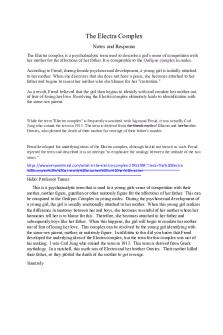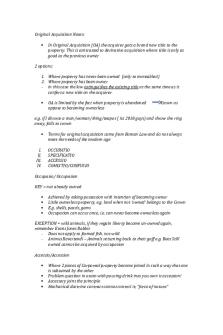Summary notes – The structure of major histocompatibility complex PDF

| Title | Summary notes – The structure of major histocompatibility complex |
|---|---|
| Course | Biology |
| Institution | University of Salford |
| Pages | 2 |
| File Size | 57.8 KB |
| File Type | |
| Total Downloads | 72 |
| Total Views | 152 |
Summary
SUmmary notes based on The structure of major histocompatibility complex are useful for exams...
Description
Summary notes – The structure of major histocompatibility complex MHC Class I Molecules The MHC Class I molecules in both human and mouse consist of two polypeptide chains that dramatically differ in size. There are larger (α) chain has a molecular weight of 44 kDa in humans and 47 kDa in the mouse, and is encoded by an MHC Class I gene. The smaller chain, called β-2 microglobulin, has a molecular weight of 12 kDa in both species, and is encoded by a nonpolymorphic gene that is mapped outside of the MHC complex. There are no known differences in the structure of the human MHC Class I antigen a chains encoded by the HLA-A locus compared to those encoded by the HLA-B or the HLA-C loci, or in the structure of the murine MHC Class I antigen a chains encoded by the H-2K locus compared to those encoded by the H-2D or H-2L loci. The MHC Class I molecules Regardless of which of these loci codes it, the a chain can be subdivided into the following regions. The peptide-binding domain; The immunoglobulin-like domain; The transmembrane domain; and the cytoplasmic domain. The peptide-binding domain is the most Nterminal; it is the only region of the molecule where allelic differences in the amino acid sequence can be localized. The peptide-binding domain of the molecule includes the site to which antigenic peptides bind. It makes much sense to have this site exactly where the allelic differences are, because different MHC alleles accommodate peptides better or worse, thus influencing on the magnitude of the T-cell response. X-ray crystallography showed that the peptidebinding site in the MHC Class I molecules looks like a cleft that has a ‘‘floor’’ and two ‘‘walls’’ formed by spiral shaped portions of the alpha chain, called alpha 1 and alpha 2. They are Since the ‘‘floor’’ of the peptide-
MHC Class II Molecules There are Class II MHC molecules in both human and mouse consist of two polypeptide chains that have a similar, albeit not identical size. They are One of them is called alpha (α) and the other beta (β). Molecular weight of the a chain is 32–34 kDa, and of the b chain 29–32 kDa. The separate gene controls each of the chains. Thus, the murine I-A locus actually consists of the Iα and Iβ genes, the human HLA-DR locus of the HLA-DRα and HLA-DRβ, etc. Both the α and the β genes are polymorphic. There are β genes of some of the MHC Class II loci can be tandemly duplicated, so, instead of one gene per homologous chromosome, a cell can have two or three. This is Because of that, one cell can simultaneously express more than two allelic products of each of the MHC Class II loci. For example, a cell can express allelic products of its HLA-DR molecule that can be identified as HLADRα1– HLA-DRβ1; HLA-DRα2 – HLA-DRβ2; HLA-DRα1 – HLA-DRβ2; HLA-DRα2 – HLA-DRβ1; etc. They are Overall, one cell can simultaneously express as many as 20 different MHC Class II gene products because of this tandem duplication phenomenon. Structure of MHC Class II antigens Figure: Structure of MHC Class II antigens There are structure of the a and the b chains of the MHC Class II molecules resembles that of the alpha chain of the MHC Class I molecules in that the former can be also divided into the peptide-binding, the immunoglobulin-like, the transmembrane and the cytoplasmic domains.
accommodating cleft is closed, only relatively small peptides, consisting of 9 to 11 amino acid residues, can be ‘‘stuffed’’ there. The immunoglobulin-like domain is structurally conserved, and resembles a domain of an antibody C-region....
Similar Free PDFs

Structure - summary of toefl
- 72 Pages

Complex Numbers summary
- 16 Pages

The structure of personality
- 6 Pages

Structure of the mammalian eye
- 4 Pages

The rise of major capitalist powers
- 11 Pages

Annulment Summary and Structure
- 3 Pages

The Electra Complex - coursework
- 2 Pages
Popular Institutions
- Tinajero National High School - Annex
- Politeknik Caltex Riau
- Yokohama City University
- SGT University
- University of Al-Qadisiyah
- Divine Word College of Vigan
- Techniek College Rotterdam
- Universidade de Santiago
- Universiti Teknologi MARA Cawangan Johor Kampus Pasir Gudang
- Poltekkes Kemenkes Yogyakarta
- Baguio City National High School
- Colegio san marcos
- preparatoria uno
- Centro de Bachillerato Tecnológico Industrial y de Servicios No. 107
- Dalian Maritime University
- Quang Trung Secondary School
- Colegio Tecnológico en Informática
- Corporación Regional de Educación Superior
- Grupo CEDVA
- Dar Al Uloom University
- Centro de Estudios Preuniversitarios de la Universidad Nacional de Ingeniería
- 上智大学
- Aakash International School, Nuna Majara
- San Felipe Neri Catholic School
- Kang Chiao International School - New Taipei City
- Misamis Occidental National High School
- Institución Educativa Escuela Normal Juan Ladrilleros
- Kolehiyo ng Pantukan
- Batanes State College
- Instituto Continental
- Sekolah Menengah Kejuruan Kesehatan Kaltara (Tarakan)
- Colegio de La Inmaculada Concepcion - Cebu








